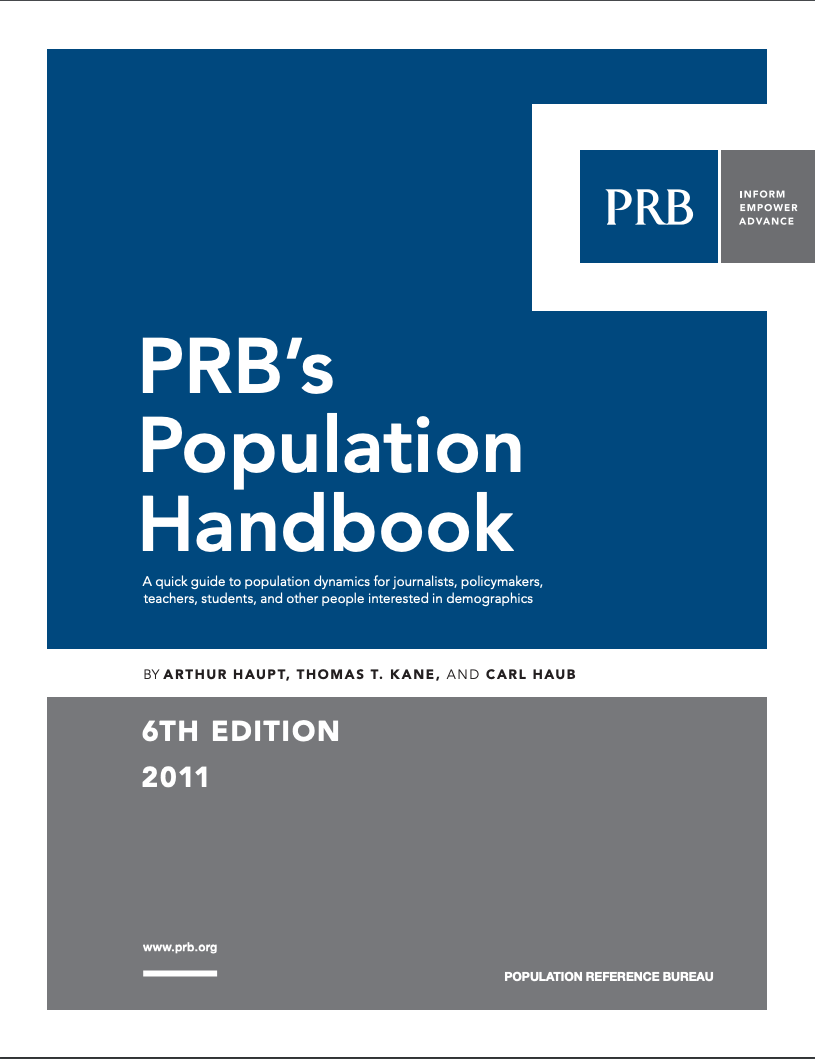
– A –
Abortion Rate The number of abortions per 1,000 women ages 15-44 or 15-49 in a given year.
Abortion Ratio The number of abortions per 1,000 live births in a given year.
Acquired Immunodeficiency Syndrome (AIDS) Applies to the most advanced stages of HIV infection. It is defined by the occurrence of any of more than 20 opportunistic infections or HIV-related cancers.
Age-Dependency Ratio The ratio of persons in the ages defined as dependent (under 15 years and over 64 years) to persons in the ages defined as economically productive (15-64 years) in a population.
Age Structure The proportion of the total population in each age group.
Age-Sex Structure The composition of a population as determined by the number or proportion of males and females in each age category. The age-sex structure of a population is the cumulative result of past trends in fertility, mortality, and migration. Information on age-sex composition is essential for the description and analysis of many other types of demographic data. See also population pyramid.
Age-Specific Rate Rate obtained for specific age groups (for example, age-specific fertility rate, death rate, marriage rate, illiteracy rate, or school enrollment rate).
Aging of Population A process in which the proportions of adults and elderly increase in a population, while the proportions of children and adolescents decrease. This process results in a rise in the median age of the population. Aging occurs when fertility rates decline while life expectancy remains constant or improves at the older ages.
Antinatalist Policy The policy of a government, society, or social group to slow population growth by attempting to limit the number of births.
Antiretroviral therapy (ART) Treatment of people infected with human immunodeficiency virus (HIV) using anti-HIV drugs. The standard treatment consists of a combination of at least three drugs (often called “highly active antiretroviral therapy” or HAART) that suppress HIV replication. Three drugs are used in order to reduce the likelihood of the virus developing resistance. ART has the potential both to reduce mortality and morbidity rates among HIV-infected people, and to improve their quality of life.
– B –
Baby Boom A dramatic increase in fertility rates and in the absolute number of births in the United States, Canada, Australia, and New Zealand during the period following World War II (1947-1961).
Baby Bust A rapid decline in U.S. fertility rates to record-low levels during the period immediately after the baby boom.
Balancing Equation A basic demographic formula used to estimate total population change between two points in time — or to estimate any unknown component of population change, provided that the other components are known. The balancing equation includes all components of population change: births, deaths, immigration, emigration, in-migration, and out-migration.
Birth Control Practices employed by couples that permit sexual intercourse with reduced likelihood of conception and birth. The term birth control is often used synonymously with such terms as contraception, fertility control, and family planning. But birth control includes abortion to prevent a birth, whereas family planning methods explicitly do not include abortion.
Birth Rate (or crude birth rate) The number of live births per 1,000 population in a given year. Not to be confused with the growth rate.
Birth Rate for Unmarried Women The number of live births per 1,000 unmarried women (never married, widowed, or divorced) ages 15-49 in a given year.
Brain Drain The emigration of a significant proportion of a country’s highly skilled, highly educated professional population, usually to other countries offering better economic and social opportunity (for example, physicians leaving a developing country to practice medicine in a developed country).
– C –
Carrying Capacity The maximum sustainable size of a resident population in a given ecosystem.
Case Fatality Rate The proportion of persons contracting a disease who die from it during a specified time period.
Case Rate The number of reported cases of a specific disease per 100,000 population in a given year.
Cause-Specific Death Rate The number of deaths attributable to a specific cause per 100,000 population in a given year.
Census A canvass of a given area, resulting in an enumeration of the entire population and often the compilation of other demographic, social, and economic information pertaining to that population at a specific time. See also survey.
Childbearing Years The reproductive age span of women, assumed for statistical purposes to be 15-44 or 15-49 years of age.
Child-Woman Ratio The number of children under age 5 per 1,000 women ages 15-44 or 15-49 in a population in a given year. This crude fertility measure, based on basic census data, is sometimes used when more specific fertility information is not available.
Closed Population A population with no migratory flow either in or out, so that changes in population size occur only through births and deaths.
Cohort A group of people sharing a common temporal demographic experience who are observed through time. For example, the birth cohort of 1900 is the people born in that year. There are also marriage cohorts, school class cohorts, and so forth.
Cohort Analysis Observation of a cohort’s demographic behavior through life or through many periods; for example, examining the fertility behavior of the cohort of people born between 1940 and 1945 through their entire childbearing years. Rates derived from such cohort analyses are cohort measures. Compare with period analysis.
Completed Fertility Rate The number of children born per woman to a cohort of women by the end of their childbearing years.
Consensual Union Cohabitation by an unmarried couple for an extended period of time. Although such unions may be quite stable, they are not regarded as legal marriages in official statistics.
Contraceptive Prevalence Percentage of couples currently using a contraceptive method.
Contraceptive Use The percentage of currently married or “in union” women (unless otherwise indicated) of reproductive age who are currently using any form of contraception. Modern methods comprise clinic and supply methods, including the pill, injectable, implant, IUD, condom, and sterilization.
Crude Rate Rate of any demographic event computed for an entire population.
– D –
Death Rate (or crude death rate) The number of deaths per 1,000 population in a given year.
Demographic Transition The historical shift of birth and death rates from high to low levels in a population. The mortality decline usually precedes the fertility decline, resulting in rapid population growth during the transition period.
Demography The scientific study of human populations, including their sizes, compositions, distributions, densities, growth, and other characteristics, as well as the causes and consequences of changes in these factors.
Dependency Ratio A dependency ratio is the ratio of people in a dependent age group (those under age 15 or ages 65 and older) to those in the economically productive age group (ages 15 to 64) of a population. For instance, a child dependency ratio of 0.45 means there are 45 children for every 100 working-age adults.
Depopulation The state of population decline.
Divorce Rate (or crude divorce rate) The number of divorces per 1,000 population in a given year.
Double Dependency Moderate child dependency and relatively high old-age dependency reflect above or near replacement fertility and declining mortality.
Doubling Time The number of years required for the population of an area to double its present size, given the current rate of population growth.
– E –
Economic Infrastructure Economic infrastructure includes the internal facilities of a country that make business and financial activity possible, such as communication, transportation, and distribution networks; financial institutions and markets; and energy supply systems.
Economic Security The condition of having stable income or other resources to support a standard of living now and in the foreseeable future.
Emigration The process of leaving one country to take up permanent or semipermanent residence in another.
Emigration Rate The number of emigrants departing an area of origin per 1,000 population in that area of origin in a given year.
Ethnicity The cultural practices, language, cuisine, and traditions — not biological or physical differences — used to distinguish groups of people.
– F –
Family Usually two or more persons living together and related by birth, marriage, or adoption. Families may consist of siblings or other relatives as well as married couples and any children they have.
Family Planning The conscious effort of couples to regulate the number and spacing of births through artificial and natural methods of contraception. Family planning connotes conception control to avoid pregnancy and abortion, but it also includes efforts of couples to induce pregnancy.
Fecundity The physiological capacity of a woman to produce a child.
Fertility The actual reproductive performance of an individual, a couple, a group, or a population. See general fertility rate.
– G –
Gender refers to the economic, social, political, and cultural attributes, constraints and opportunities associated with being a woman or a man. The social definitions of what it means to be a woman or a man vary among cultures and change over time. Gender is a sociocultural expression of particular characteristics and roles that are associated with certain groups of people with reference to their sex and sexuality.
Gender Equity is the process of being fair to women and men. To ensure fairness, measures must be taken to compensate for historical and social disadvantages that prevent women and men from operating on a level playing field.
Gender Equality is the state or condition that affords women and men equal enjoyment of human rights, socially valued goods, opportunities, and resources.
General Fertility Rate The number of live births per 1,000 women ages 15-44 or 15-49 years in a given year.
Gross National Income (GNI) GNI (formerly GNP) is the sum of value added by all resident producers plus any product taxes (less subsidies) not included in the valuation of output plus net receipts of primary income (compensation of employees and property income) from abroad. Data are in current U.S. dollars. GNI, calculated in national currency, is usually converted to U.S. dollars at official exchange rates for comparisons across economies, although an alternative rate is used when the official exchange rate is judged to diverge by an exceptionally large margin from the rate actually applied in international transactions.
Gross Reproduction Rate (GRR) The average number of daughters that would be born alive to a woman (or group of women) during her lifetime if she passed through her childbearing years conforming to the age-specific fertility rates of a given year. See also net reproduction rate and total fertility rate.
Growth Rate The number of people added to (or subtracted from) a population in a year due to natural increase and net migration expressed as a percentage of the population at the beginning of the time period.
– H –
High Child Dependency High fertility and relatively high mortality contribute to a large young population and a small old-age population.
High-risk pregnancies Pregnancies occurring under the following conditions: too closely spaces, too frequent, mother too young or too old, or accompanied by such high-risk factors as high blood pressure or diabetes.
High-Old-Age Dependency Moderate child dependency and relatively high old-age dependency reflect above or near replacement fertility and declining mortality.
Household One or more persons occupying a housing unit.
Human Immunodeficiency Virus (HIV) Retrovirus that infects cells of the immune system, destroying or impairing their function. As the infection progresses, the immune system becomes weaker, and the person becomes more susceptible to infections.
HIV is transmitted through unprotected sexual intercourse, transfusion of contaminated blood, sharing of contaminated needles, and between a mother and her infant during pregnancy, childbirth and breastfeeding.
– I –
Immigration The process of entering one country from another to take up permanent or semipermanent residence.
Immigration Rate The number of immigrants arriving at a destination per 1,000 population at that destination in a given year.
Incidence Rate The number of persons contracting a disease per 1,000 population at risk, for a given period of time.
Infant Mortality Rate The number of deaths of infants under age 1 per 1,000 live births in a given year.
In-migration The process of entering one administrative subdivision of a country (such as a province or state) from another subdivision to take up residence.
– L –
Least Developed Countries Following United Nations’ definitions, the term “least developed countries” includes as of March 2018: Afghanistan, Angola, Bangladesh, Benin, Bhutan, Burkina Faso, Burundi, Cambodia, Central African Republic, Chad, Comoros, Democratic Republic of the Congo, Djibouti, Eritria, Ethiopia, Gambia, Guinea, Guinea-Bissau, Haiti, Kiribati, Lao People’s Democratic Republic, Lesotho, Liberia, Madagascar, Malawi, Mali, Mauritania, Mozambique, Myanmar, Nepal, Niger, Rwanda, São Tomé and Príncipe, Senegal, Sierra Leone, Solomon Islands, Somalia, Sudan, Timor-Leste, Togo, Tuvalu, Uganda, Vanuatu, Yemen, and Zambia. These countries are also “less developed” in United Nations’ terminology.
Less Developed Countries Following United Nations’ definitions, the term “less developed countries” (or regions) refers to countries in Africa, Asia (except Japan), Latin America and the Caribbean, and Oceania (except Australia and New Zealand).
Life Expectancy The average number of additional years a person could expect to live if current mortality trends were to continue for the rest of that person’s life. Most commonly cited as life expectancy at birth.
Life Span The maximum age that human beings could reach under optimum conditions.
Life Table A tabular display of life expectancy and the probability of dying at each age (or age group) for a given population, according to the age-specific death rates prevailing at that time. The life table gives an organized, complete picture of a population’s mortality.
Low Overall Dependency Sustained immigration of working-age adults, with a small share of the population ages 65+, results in low overall dependency.
– M –
Male Involvement means engaging men in actively promoting gender equity with regard to reproductive health, increases men’s support for women’s reproductive health and children’s well-being, and advances the reproductive health of both men and women.
Malthus, Thomas R. (1766-1834) English clergyman and economist famous for his theory (expounded in the ‘Essay on the Principle of Population’) that the world’s population tends to increase faster than the food supply and that unless fertility is controlled (by late marriage or celibacy), famine, disease, and war must serve as natural population restrictions. See neo-Malthusian.
Marital Fertility Rate Number of live births to married women per 1,000 married women ages 15-44 or 15-49 in a given year.
Marriage Rate (or crude marriage rate) The number of marriages per 1,000 population in a given year.
Maternal Mortality Ratio The number of women who die as a result of pregnancy and childbirth complications per 100,000 live births in a given year.
Mean Age The mathematical average age of all the members of a population.
Median Age The age that divides a population into two numerically equal groups; that is, half the people are younger than this age and half are older.
Megalopolis A term denoting an interconnected group of cities and connecting urbanized bands.
MENA Countries The Middle East and North Africa (MENA) is an economically diverse region that includes both the oil-rich economies in the Gulf and countries that are resource-scarce in relation to population. The region’s economic fortunes over much of the past quarter century have been heavily influenced by two factors: the price of oil and the legacy of economic policies and structures that had emphasized a leading role for the state. The MENA region includes: Algeria, Bahrain, Djibouti, Egypt, Iran, Iraq, Israel, Jordan, Kuwait, Lebanon, Libya, Malta, Morocco. Oman, Qatar, Saudi Arabia, Syria, Tunisia, United Arab Emirates, West Bank and Gaza, and Yemen.
Metropolitan Area A large concentration of population, usually an area with 100,000 or more people. The area typically includes an important city with 50,000 or more inhabitants and the administrative areas bordering the city that are socially and economically integrated with it.
Migration The movement of people across a specified boundary for the purpose of establishing a new or semipermanent residence. Divided into international migration (migration between countries) and internal migration (migration within a country).
Millennium Development Goals (MDGs) The United Nations Millennium Development Goals are eight goals that all 191 UN member states have agreed to try to achieve by the year 2015. The United Nations Millennium Declaration, signed in September 2000, commits world leaders to combat poverty, hunger, disease, illiteracy, environmental degradation, and discrimination against women. The MDGs are derived from this declaration, and all have specific targets and indicators.
Mobility The geographic movement of people.
Moderate Child Dependency Declining fertility lowers child dependency to a moderate level; relatively high mortality keeps old-age dependency low.
More Developed Countries Following United Nations’ definitions, “more developed countries,” or industrialized countries (or regions), include Europe (including all of Russia), the United States, Canada, Australia, New Zealand, and Japan.
Mortality Deaths as a component of population change.
– N –
Natality Births as a component of population change.
Natural Increase (or Decrease) The surplus (or deficit) of births over deaths in a population in a given time period.
Neo-Malthusian An advocate of restricting population growth through the use of birth control. (Thomas Malthus himself did not advocate birth control as a remedy for rapid population growth.)
Neonatal Mortality Rate The number of deaths to infants under 28 days of age in a given year per 1,000 live births in that year.
Net Migration The estimated rate of net migration (immigration minus emigration) per 1,000 population. For some countries, data are derived as a residual from estimated birth, death, and population growth rates.
Net Migration Rate The net effect of immigration and emigration on an area’s population, expressed as an increase or decrease per 1,000 population of the area in a given year.
Net Reproduction Rate (NRR) The average number of daughters that would be born to a woman (or a group of women) if she passed through her lifetime conforming to the age-specific fertility and mortality rates of a given year. This rate is similar to the gross reproduction rate but takes into account that some women will die before completing their childbearing years. An NRR of one means that each generation of mothers is having exactly enough daughters to replace itself in the population. See also total fertility rate and replacement-level fertility.
Nuptiality The frequency, characteristics, and dissolution of marriages in a population.
– O –
“Old” Population A population with a relatively high proportion of middle-age and elderly persons, a high median age, and thus a lower growth potential.
Out-migration The process of leaving one subdivision of a country to take up residence in another.
– P –
Parity The number of children previously born alive to a woman; for example, ‘two-parity women’ are women who have had two children and ‘zero-parity women’ have had no live births.
Percent Urban Percentage of the total population living in areas termed “urban” by that country or by the UN.
Perinatal Mortality Rate The number of fetal deaths after 28 weeks of pregnancy (late fetal deaths) plus the number of deaths to infants under 7 days of age per 1,000 live births.
Period Analysis Observation of a population at a specific period of time. Such an analysis in effect takes a ‘snapshot’ of a population in a relatively short time period — for example, one year. Most rates are derived from period data and therefore are period rates. Compare to cohort analysis.
Population A group of objects or organisms of the same kind.
Population Control A broad concept that addresses the relationship between fertility, mortality, and migration, but is most commonly used to refer to efforts to slow population growth through action to lower fertility. It should not be confused with family planning. See also family planning.
Population Density Population per unit of land area; for example, people per square mile or people per square kilometer of arable land.
Population Distribution The patterns of settlement and dispersal of a population.
“Population Explosion” (or “Population Bomb”) Expressions used to describe the 20th century worldwide trend of rapid population growth, resulting from a world birth rate much higher than the world death rate.
Population Increase The total population increase resulting from the interaction of births, deaths, and migration in a population in a given period of time.
Population Momentum The tendency for population growth to continue beyond the time that replacement-level fertility has been achieved because of the relatively high concentration of people in the childbearing years.
Population Policy Explicit or implicit measures instituted by a government to influence population size, growth, distribution, or composition.
Population Projection Computation of future changes in population numbers, given certain assumptions about future trends in the rates of fertility, mortality, and migration. Demographers often issue low, medium, and high projections of the same population, based on different assumptions of how these rates will change in the future.
Population Pyramid A bar chart, arranged vertically, that shows the distribution of a population by age and sex. By convention, the younger ages are at the bottom, with males on the left and females on the right.
Population Register A government data collection system in which the demographic and socioeconomic characteristics of all or part of the population are continuously recorded. Denmark, Sweden, and Israel are among the countries that maintain universal registers for demographic purposes — recording the major events (birth, marriage, moves, death) that happen to each individual so that up-to-date information on the whole population is readily available. Other countries, like the United States, keep partial registers, such as social security and voter registration, for administrative purposes.
Post-Neonatal Mortality Rate The annual number of deaths of infants ages 28 days to 1 year per 1,000 live births in a given year.
Prevalence Rate The number of people having a particular disease at a given point in time per 1,000 population at risk.
Pronatalist Policy The policy of a government, society, or social group to increase population growth by attempting to raise the number of births.
Purchasing Power The ability of consumers to acquire goods and services based on their possession of money and/or their recourse to credit.
“Push-Pull” Hypothesis A migration theory that suggests that circumstances at the place of origin (such as poverty and unemployment) repel or push people out of that place to other places that exert a positive attraction or pull (such as a high standard of living or job opportunities).
– R –
Race Race is defined primarily by society, not by genetics, and there are no universally accepted categories.
Rate of Natural Increase (or Decrease) The rate at which a population is increasing (or decreasing) in a given year due to a surplus (or deficit) of births over deaths, expressed as a percentage of the base population.
Remarriage Rate The number of remarriages per 1,000 formerly married (that is, widowed or divorced) men or women in a given year.
Replacement–Level Fertility The level of fertility at which a couple has only enough children to replace themselves, or about two children per couple.
Reproductive Age See childbearing years.
Reproductive Health Reproductive health is a state of complete physical, mental, and social well-being and not merely the absence of disease or infirmity, in all matters relating to the reproductive system and to its functions and processes.
– S –
Sex Ratio The number of males per 100 females in a population.
Social Mobility A change in status (for example, an occupational change).
Stable Population A population with an unchanging rate of growth and an unchanging age composition as a result of age-specific birth and death rates that have remained constant over a sufficient period of time.
Survey A canvass of selected persons or households in a population usually used to infer demographic characteristics or trends for a larger segment or all of the population. See also census.
Survival Rate The proportion of persons in a specified group (age, sex, or health status) alive at the beginning of an interval (such as a five-year period) who survive to the end of the interval.
– T –
Total Fertility Rate (TFR) The average number of children that would be born alive to a woman (or group of women) during her lifetime if she were to pass through her childbearing years conforming to the age-specific fertility rates of a given year. This rate is sometimes stated as the number of children women are having today. See also gross reproduction rate and net reproduction rate.
– U –
Under 5 (U5) Child Mortality Probability of a child born in a specific year or period dying before reaching the age of 5.
Undocumented Immigrant A foreigner who has entered a country without inspection or without proper documents, or who has violated the terms of legal admission to the country, for example, by overstaying the duration of a tourist or student visa.
Unmet Need Women with unmet need for spacing births are those who are able to become pregnant and sexually active but are not using any method of contraception (modern or traditional), and report wanting to delay the next child or limit their number of births. The concept of unmet need points to the gap between women’s reproductive intentions and their contraceptive behavior.
Urban Countries differ in the way they classify population as ‘urban’ or ‘rural.’ Typically, a community or settlement with a population of 2,000 or more is considered urban. A listing of country definitions is published annually in the United Nations Demographic Yearbook.
Urbanization Growth in the proportion of a population living in urban areas.
– V –
Vital statistics Demographic data on births, deaths, fetal deaths, marriages and divorces.
– W –
Women’s Empowerment means improving the status of women to enhance their decisionmaking capacity at all levels, especially as it relates to their sexuality and reproductive health.
– Y –
“Young” Population A population with a relatively high proportion of children, adolescents, and young adults; a low median age; and thus a high growth potential.
– Z –
Zero Population Growth A population in equilibrium, with a growth rate of zero, achieved when births plus immigration equal deaths plus emigration.

What Is the American Community Survey?
Assessing the Reliability of ACS Estimates
PRB developed a video tutorial series to introduce data users to the American Community Survey (ACS) and provide key information about how to access and use ACS data.
The U.S. Census Bureau’s ACS provides detailed social, economic, housing, and demographic statistics for the United States and its communities every year. Data analysts, government officials, businesses, and many others use these statistics for local planning and policy development, and to track the population’s well-being.
Through these tutorials, you’ll also learn where to find additional resources available through the U.S. Census Bureau.
These tutorials were funded by the Annie E. Casey Foundation. We thank them for their support. The material presented in these videos is by PRB alone and does not necessarily reflect the opinions of the Foundation.






